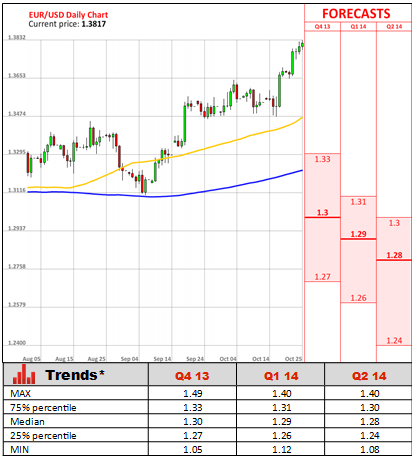After hitting a two-year high of 1.382 on Wednesday, the single currency pulled back, following releases from the Eurozone and its largest economy, Germany, where manufacturing and services data disappointed market participants. According to a report from Markit Economics, conditions in the 17-nation bloc's manufacturing sector improved slightly, as manufacturing PMI inched up to 51.3 from 51.1 in September, however, still below analysts' expectations for a 51.4 figure. Furthermore, services PMI eased to 50.9, while the composite PMI fell to 51.5, hitting the lowest in two months. Nonetheless, all indicators are above the 50 threshold, which separates growth from contraction. The flash manufacturing PMI is a key gauge of overall economic health in the whole region, as companies respond quickly to even slight changes in market conditions. German manufacturing PMI, meanwhile, improved to 51.5 in October, while services PMI pulled back to 51.5 from 52.2 in September. While analysts and politicians are suggesting the bloc will start gaining momentum and the worse is over, the latest figures are suggesting a sustainable upturn is not assured and there is no room for complacency. It also supports ECB's view the recovery remains slow, fragile and uneven. Despite all challenges, European policymakers are moving towards creating a closer banking union that would assure stability of the banking sector, while the ECB is likely to stay pat on its monetary policy during November's policy meeting.
Note: This section contains information in English only.
"The dip in the PMI in October is clearly disappointing, but it would be unwise to read too much into one month's data"
After hitting a two-year high of 1.382 on Wednesday, the single currency pulled back, following releases from the Eurozone and its largest economy, Germany, where manufacturing and services data disappointed market participants. According to a report from Markit Economics, conditions in the 17-nation bloc's manufacturing sector improved slightly, as manufacturing PMI inched up to 51.3 from 51.1 in September, however, still below analysts' expectations for a 51.4 figure. Furthermore, services PMI eased to 50.9, while the composite PMI fell to 51.5, hitting the lowest in two months. Nonetheless, all indicators are above the 50 threshold, which separates growth from contraction. The flash manufacturing PMI is a key gauge of overall economic health in the whole region, as companies respond quickly to even slight changes in market conditions. German manufacturing PMI, meanwhile, improved to 51.5 in October, while services PMI pulled back to 51.5 from 52.2 in September. While analysts and politicians are suggesting the bloc will start gaining momentum and the worse is over, the latest figures are suggesting a sustainable upturn is not assured and there is no room for complacency. It also supports ECB's view the recovery remains slow, fragile and uneven. Despite all challenges, European policymakers are moving towards creating a closer banking union that would assure stability of the banking sector, while the ECB is likely to stay pat on its monetary policy during November's policy meeting.

Fri, 25 Oct 2013 05:36:03 GMT
Source: Dukascopy Bank SA
- Chris Williamson, chief economist at Markit
After hitting a two-year high of 1.382 on Wednesday, the single currency pulled back, following releases from the Eurozone and its largest economy, Germany, where manufacturing and services data disappointed market participants. According to a report from Markit Economics, conditions in the 17-nation bloc's manufacturing sector improved slightly, as manufacturing PMI inched up to 51.3 from 51.1 in September, however, still below analysts' expectations for a 51.4 figure. Furthermore, services PMI eased to 50.9, while the composite PMI fell to 51.5, hitting the lowest in two months. Nonetheless, all indicators are above the 50 threshold, which separates growth from contraction. The flash manufacturing PMI is a key gauge of overall economic health in the whole region, as companies respond quickly to even slight changes in market conditions. German manufacturing PMI, meanwhile, improved to 51.5 in October, while services PMI pulled back to 51.5 from 52.2 in September. While analysts and politicians are suggesting the bloc will start gaining momentum and the worse is over, the latest figures are suggesting a sustainable upturn is not assured and there is no room for complacency. It also supports ECB's view the recovery remains slow, fragile and uneven. Despite all challenges, European policymakers are moving towards creating a closer banking union that would assure stability of the banking sector, while the ECB is likely to stay pat on its monetary policy during November's policy meeting.
© Dukascopy Bank SA
Actual Topics
Subscribe to "Fundamental Analysis" feed
Subscribe
Aby dowiedzieć się więcej o handlu Forex/CFD na platformie Dukascopy Banku, rynku SWFX oraz innych rzeczy związanych z handlem,
zadzwoń do nas lub poproś o oddzwonienie.
zadzwoń do nas lub poproś o oddzwonienie.
For further information regarding potential cooperation,
please call us or make callback request.
please call us or make callback request.
Aby dowiedzieć się więcej o Opcjach Binarnych w Banku Dukascopy / platformach handlowych Forex, SWFX, oraz innych,
zadzwoń do nas lub pozostaw prośbę o oddzwonienie.
zadzwoń do nas lub pozostaw prośbę o oddzwonienie.
Aby dowiedzieć się więcej o handlu Forex/CFD na platformie Dukascopy Banku, rynku SWFX oraz innych rzeczy związanych z handlem,
zadzwoń do nas lub poproś o oddzwonienie.
zadzwoń do nas lub poproś o oddzwonienie.
To learn more about Crypto Trading / CFD / Forex trading platform, SWFX and other trading related information,
please call us or make callback request.
please call us or make callback request.
To learn more about Business Introducer and other trading related information,
please call us or make callback request.
please call us or make callback request.
For further information regarding potential cooperation,
please call us or make callback request.
please call us or make callback request.